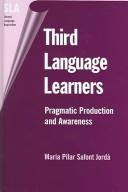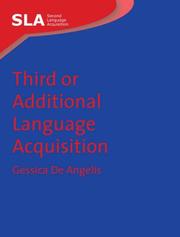| Listing 1 - 4 of 4 |
Sort by
|

ISBN: 1788920481 1280828544 9786610828548 9781853598047 1853598046 9781853598043 9781853598036 1853598038 9781853598029 185359802X 9781788920483 9781280828546 6610828547 Year: 2018 Publisher: Clevedon Channel View Publications
Abstract | Keywords | Export | Availability | Bookmark
 Loading...
Loading...Choose an application
- Reference Manager
- EndNote
- RefWorks (Direct export to RefWorks)
The book focuses on one aspect of foreign language acquisition that has not received much attention, that of the effect of bilingualism in the oral production of the English language learners. Two research areas have tackled this issue separately. On the one hand, third language acquisition researchers have analysed bilingualism effects in the acquisition of a third language. On the other hand, studies in interlanguage pragmatics have taken into account variables affecting the use of request acts by second language learners of English. The two research areas are connected in this volume, as it deals with bilingualism effects in the pragmatic production and awareness of third language learners of English. The first part of the book includes a theoretical description of research conducted in the areas of third language acquisition and interlanguage pragmatics, and the second part presents a detailed description of the empirical study carried out in a multilingual speech community.
Language and languages --- Pragmatics. --- Language awareness. --- Linguistic awareness --- Metalinguistic knowledge --- Awareness --- Psycholinguistics --- Pragmalinguistics --- General semantics --- Logic, Symbolic and mathematical --- Semantics (Philosophy) --- Foreign language study --- Language and education --- Language schools --- Study and teaching. --- Philosophy --- Language and languages Study and teaching --- Study and teaching --- Bilingualism . --- ELLs. --- English language learner. --- L3 acquisition. --- Multilingualism. --- foreign language acquisition. --- pragmatics . --- second language learners. --- third language acquisition.

ISBN: 1788920562 1280934980 9786610934980 184769005X 9781847690050 9781847690043 1847690041 9781847690036 1847690033 Year: 2018 Publisher: Clevedon Channel View Publications
Abstract | Keywords | Export | Availability | Bookmark
 Loading...
Loading...Choose an application
- Reference Manager
- EndNote
- RefWorks (Direct export to RefWorks)
Third or Additional Language Acquisition examines research on the acquisition of languages beyond the L2 within four main areas of inquiry: cross linguistic influence, multilingual speech production models, the multilingual lexicon and the impact of bi/multilingualism on cognitive development. The book critically examines the evidence available keeping two main questions in mind. The first is whether multilinguals should be considered as learners and speakers in their own right and, consequently, whether the distinction between Second Language Acquisition and Bilingualism, and Third or Additional Language Acquisition and Multilingualism is fully warranted. The second is how proficient in a non-native language learners are supposed to be before they can begin to be classified as multilingual learners in empirical research
Multilingualism. --- Language and languages --- Foreign language study --- Language and education --- Language schools --- Plurilingualism --- Polyglottism --- Study and teaching. --- Language and languages Study and teaching --- Study and teaching --- Additional Language Acquisition. --- Bilingualism . --- L3 acquisition. --- L3. --- SLA. --- Second Language Acquisition. --- Third Language Acquisition. --- cognitive development. --- crosslinguistic influence. --- multilingual lexico. --- multilingual speech production. --- multilingualism. --- transfer.
Book
Year: 2021 Publisher: Basel, Switzerland MDPI - Multidisciplinary Digital Publishing Institute
Abstract | Keywords | Export | Availability | Bookmark
 Loading...
Loading...Choose an application
- Reference Manager
- EndNote
- RefWorks (Direct export to RefWorks)
This Special Issue includes fifteen original state-of-the-art research articles from leading scholars that examine cross-linguistic influence in bilingual speech. These experimental studies contribute to the growing number of studies on multilingual phonetics and phonology by introducing novel empirical data collection techniques, sophisticated methodologies, and acoustic analyses, while also presenting findings that provide robust theoretical implications to a variety of subfields, such as L2 acquisition, L3 acquisition, laboratory phonology, acoustic phonetics, psycholinguistics, sociophonetics, blingualism, and language contact. These studies in this book further elucidate the nature of phonetic interactions in the context of bilingualism and multilingualism and outline future directions in multilingual phonetics and phonology research.
second language acquisition --- phonology --- discrimination --- cross-linguistic assimilation --- obstruent --- affricate --- fricative --- dialect --- English --- Spanish --- L1 attrition --- speech --- foreign accent --- accent perception --- bilingual --- teacher --- bilingualism --- phonetics --- language mode --- cross-linguistic influence --- transfer --- voice onset time --- global accent rating --- American English --- Russian --- voicing --- classroom learning --- first language drift --- perceptual learning --- individual differences --- phonetic sensitivity --- crosslinguistic influence --- Korean --- laryngeal contrast --- vowel inventory --- heritage bilingualism --- early bilingualism --- speech production --- multilingualism --- third language acquisition --- speech perception --- rhotics --- final obstruent devoicing --- Korean Americans --- California Vowel Shift --- second language phonology --- immigrant minority speakers --- sound change --- Spanish-English bilinguals --- gender --- vowels --- vowel centralization --- vowel sequences --- sociophonetics --- competence --- fricative epithesis --- vowel devoicing --- center of gravity --- French --- acquisition --- agentivity --- directionality --- fricative (de)voicing --- Catalan–Spanish contact --- intonation --- language contact --- language attitudes --- social factors --- Basque --- Perceptual Assimilation Model --- second language speech learning --- English /r/ and /l/ --- Japanese --- English as a second language --- categorical perception --- compromise VOT --- voice timing --- performance mismatches --- dynamic phonetic interactions --- acoustic similarity --- perceptual similarity --- non-native discrimination --- non-native categorisation
Book
Year: 2021 Publisher: Basel, Switzerland MDPI - Multidisciplinary Digital Publishing Institute
Abstract | Keywords | Export | Availability | Bookmark
 Loading...
Loading...Choose an application
- Reference Manager
- EndNote
- RefWorks (Direct export to RefWorks)
This Special Issue includes fifteen original state-of-the-art research articles from leading scholars that examine cross-linguistic influence in bilingual speech. These experimental studies contribute to the growing number of studies on multilingual phonetics and phonology by introducing novel empirical data collection techniques, sophisticated methodologies, and acoustic analyses, while also presenting findings that provide robust theoretical implications to a variety of subfields, such as L2 acquisition, L3 acquisition, laboratory phonology, acoustic phonetics, psycholinguistics, sociophonetics, blingualism, and language contact. These studies in this book further elucidate the nature of phonetic interactions in the context of bilingualism and multilingualism and outline future directions in multilingual phonetics and phonology research.
Language --- second language acquisition --- phonology --- discrimination --- cross-linguistic assimilation --- obstruent --- affricate --- fricative --- dialect --- English --- Spanish --- L1 attrition --- speech --- foreign accent --- accent perception --- bilingual --- teacher --- bilingualism --- phonetics --- language mode --- cross-linguistic influence --- transfer --- voice onset time --- global accent rating --- American English --- Russian --- voicing --- classroom learning --- first language drift --- perceptual learning --- individual differences --- phonetic sensitivity --- crosslinguistic influence --- Korean --- laryngeal contrast --- vowel inventory --- heritage bilingualism --- early bilingualism --- speech production --- multilingualism --- third language acquisition --- speech perception --- rhotics --- final obstruent devoicing --- Korean Americans --- California Vowel Shift --- second language phonology --- immigrant minority speakers --- sound change --- Spanish-English bilinguals --- gender --- vowels --- vowel centralization --- vowel sequences --- sociophonetics --- competence --- fricative epithesis --- vowel devoicing --- center of gravity --- French --- acquisition --- agentivity --- directionality --- fricative (de)voicing --- Catalan–Spanish contact --- intonation --- language contact --- language attitudes --- social factors --- Basque --- Perceptual Assimilation Model --- second language speech learning --- English /r/ and /l/ --- Japanese --- English as a second language --- categorical perception --- compromise VOT --- voice timing --- performance mismatches --- dynamic phonetic interactions --- acoustic similarity --- perceptual similarity --- non-native discrimination --- non-native categorisation
| Listing 1 - 4 of 4 |
Sort by
|

 Search
Search Feedback
Feedback About UniCat
About UniCat  Help
Help News
News